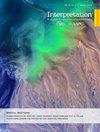Decomposing and recovering airborne radiometric data through principal component analysis applied on flight-line data: An alternative to reduce noise
IF 1.1
4区 地球科学
Q3 GEOCHEMISTRY & GEOPHYSICS
Interpretation-A Journal of Subsurface Characterization
Pub Date : 2023-05-11
DOI:10.1190/int-2022-0110.1
引用次数: 0
Abstract
Airborne gamma-ray spectrometry (AGRS) data provide valuable information about the distribution of radiometric elements on Earths surface. However, the presence of noise can hinder the interpretation or the identification of subtle variations of radioelement concentrations that can be economically attractive. Previous research demonstrated that techniques based on matrix factorization, such as Noise Adjusted Singular Value Decomposition (NASDV) and Minima Noise Fraction (MNF), can reduce noise when applied to AGRS raw spectra. Nevertheless, the raw spectra are often unavailable for end-users, limiting the widespread adoption of such techniques. In this context, we propose using Principal Component Analysis (PCA) with the flight-line data before interpolating the data onto a regular grid as a means to reduce noise when the raw spectra are no longer available. We used our approach on two AGRS datasets located in Brazil and one in the United States of America (U.S.A). For Brazils AGRS data, results show that noise can be attenuated through eigendecomposition projection and recovery of the radiometric variables. Furthermore, the technique we propose can highlight some geological features dependent on the number of eigenvectors used to reconstruct the database. For the U.S.A's AGRS dataset previously filtered with NASDV, the proposed methodology seems to produce only marginal improvement. Therefore, our methodology might be particularly successful for AGRS data whose acquisitions were conducted before NASDV and MNF were proposed as radiometric data processing techniques.#xD;利用主成分分析对航线数据进行分解和恢复:一种降低噪声的替代方法
航空伽马射线光谱(AGRS)数据提供了关于地球表面辐射元素分布的有价值的信息。然而,噪声的存在可能会阻碍解释或识别具有经济吸引力的放射性元素浓度的细微变化。先前的研究表明,基于矩阵分解的技术,如噪声调整奇异值分解(NASDV)和最小噪声分数(MNF),在应用于AGRS原始频谱时可以降低噪声。然而,最终用户往往无法获得原始光谱,这限制了此类技术的广泛采用。在这种情况下,我们建议在将数据插值到规则网格上之前,对飞行线数据使用主成分分析(PCA),作为在原始频谱不再可用时减少噪声的一种手段。我们在位于巴西和美国的两个AGRS数据集上使用了我们的方法。对于巴西的AGRS数据,结果表明,可以通过本征分解投影和辐射变量的恢复来衰减噪声。此外,我们提出的技术可以突出一些地质特征,这取决于用于重建数据库的特征向量的数量。对于之前用NASDV过滤的美国AGRS数据集,所提出的方法似乎只产生了微不足道的改进。因此,对于在NASDV和MNF被提议作为辐射数据处理技术之前进行采集的AGRS数据,我们的方法可能特别成功#xD;
本文章由计算机程序翻译,如有差异,请以英文原文为准。
求助全文
约1分钟内获得全文
求助全文
来源期刊

Interpretation-A Journal of Subsurface Characterization
GEOCHEMISTRY & GEOPHYSICS-
CiteScore
2.50
自引率
8.30%
发文量
126
期刊介绍:
***Jointly published by the American Association of Petroleum Geologists (AAPG) and the Society of Exploration Geophysicists (SEG)***
Interpretation is a new, peer-reviewed journal for advancing the practice of subsurface interpretation.
 求助内容:
求助内容: 应助结果提醒方式:
应助结果提醒方式:


